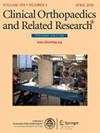Statistical Groupings of Mental Health and Osteoarthritis Severity Correlate With 10-year Trajectories of Levels of Capability and Comfort Among People With Hip Pain: A Nationwide Prospective Cohort Study (CHECK).
IF 4.2
2区 医学
Q1 ORTHOPEDICS
引用次数: 0
Abstract
BACKGROUND Among patients seeking care for osteoarthritis (OA), there is evidence that mindsets contribute more to variation in levels of musculoskeletal discomfort and incapability than does radiographic severity. While the importance of mindsets among those seeking specialty care is well established, less is known about the relationship of thoughts and feelings with levels of joint-related discomfort and incapability in the general population, many of whom experience symptoms of aging joints and are accommodating these symptoms. By studying individuals with hip pain who have not sought specialty care, using a statistical technique that can account for the interrelationship of psychological and social variables (cluster analysis) and accounting for levels of OA, we can better study the association of mindset with levels of discomfort and incapability relative to the grade of OA while limiting or avoiding the potential for distortion of linear and logistic regression by even relatively lower levels of collinearity among mental health variables. QUESTIONS/PURPOSES Using a Dutch population-based cohort we asked: (1) Are there distinct 10-year trajectories of comfort and capability by statistical grouping based on mental health measures and grade of OA in a population-based cohort of individuals with hip pain? (2) Are groupings with less healthy mindsets associated with worse 10-year trajectories for both comfort and capability compared with groups defined by healthier mindsets? METHODS We analyzed data from a prospective longitudinal cohort from the Dutch general population from between October 2002 and September 2005. Individuals age 45 to 65 years were included if they experienced new onset of hip or knee pain or stiffness and either had not sought care for their symptoms or their first general practitioner consultation for symptoms was within 6 months of enrollment. Originally, a total of 1002 participants were included, of which 74% (n = 740, 79% [584 of 740] women, mean ± SD age 56 ± 5 years) met our inclusion criteria and were included in this study. Each year for 10 years, participants completed the SF-36 (measuring general capability and mental health, with higher scores indicating better overall health); the WOMAC questionnaire (measuring capability specifically for hip and knee OA, with lower scores indicating greater capability); the EuroQol-5D-3L (EQ-5D-3L) questionnaire, which measures five domains of health (mobility, self-care, usual activities, pain, and anxiety/depression); and the VAS for pain intensity. All 740 included participants completed the WOMAC, the SF-36 physical component summary, and the Numeric Rating Scale for pain at 10 years. Cluster analysis identified statistical groupings of participants with similar scores on the SF-36 mental component summary (MCS), EQ-5D-3L anxiety/depression item, and Kellgren-Lawrence grade of radiographic hip OA. We then constructed a conditional growth model, which is a statistical technique that analyzes the average rate of decline in capability and increase in pain intensity over 10 years between groups of people with similar baseline mental health and radiographic arthritis severity. The conditional growth model quantifies the relationship between mindset and grade of OA at baseline and 10-year trajectories of levels of comfort and capability. RESULTS The cluster analysis identified four statistical groups of participants with similar mean grades of radiographic OA at the 10-year evaluation and variation in mental health scores. All groups had a mean Kellgren-Lawrence Grade of 2. Group 1, summarized as "accommodative mindset" (44% [326 of 740] of patients), had high mean scores on the SF-36 MCS (a mean of 60, which represents an SD better than the population mean of 50) and low mean scores on the EQ-5D-3L anxiety/depression questions, representing minimal symptoms of anxiety and depression. Group 2, summarized as "neutral mindset" (37% [276 of 740] of patients), had scores near the population mean of 50 on the SF-36 MCS and slightly higher mean scores on the EQ-5D-3L anxiety/depression questions, representing relatively neutral mental health. Group 3, summarized as "less healthy mindsets" (12% [89 of 740] of patients), had mean scores of 1 SD below the population mean on the SF-36 MCS and higher mean scores on the EQ-5D-3L anxiety/depression questions, representing relatively greater symptoms of anxiety and depression. Group 4, summarized as "least healthy mindset" (6% [45 of 740] of patients), had mean scores of 2 SD below the population mean on the SF-36 MCS and high mean scores on the EQ-5D-3L anxiety/depression questions, representing notable symptoms of anxiety and depression. Patients with less healthy mindsets experienced more rapid decline in comfort and capability over a decade. CONCLUSION The finding among the general population of people with hip pain-many of whom have sensations from hip arthritis but are not seeking care-that worse mental health accounted for worse 10-year trajectories of hip symptoms independent of the radiographic severity of hip arthritis is further evidence that strategies for enhancing musculoskeletal health must account for symptoms of anxiety and depression. Seeking care for hip pain from relatively mild arthritis might, in part, signal higher levels of emotional distress. Timely diagnosis and effective treatment of unhealthy levels of anxiety and depression have the potential to improve a patient's hip health and their health in general. LEVEL OF EVIDENCE Level II, prognostic study.心理健康和骨关节炎严重程度的统计分组与髋关节疼痛患者的能力和舒适水平的10年轨迹相关:一项全国前瞻性队列研究(CHECK)。
背景:在寻求骨关节炎(OA)治疗的患者中,有证据表明,心态对肌肉骨骼不适和残疾水平的影响比放射学严重程度更大。虽然在寻求专业护理的人群中,心态的重要性是公认的,但对于一般人群中与关节相关的不适和丧失能力水平的思想和感觉之间的关系,人们知之甚少,许多人经历了关节老化的症状,并正在适应这些症状。通过研究没有寻求专业护理的髋关节疼痛患者,使用一种可以解释心理和社会变量(聚类分析)之间相互关系的统计技术,并考虑OA水平,我们可以更好地研究心态与相对于OA等级的不适和丧失能力水平的关联,同时限制或避免线性和逻辑回归的潜在扭曲,即使心理健康变量之间的共线性水平相对较低。问题/目的:采用荷兰人群为基础的队列研究,我们提出以下问题:(1)在以人群为基础的髋关节疼痛患者队列中,通过基于心理健康测量和OA等级的统计分组,舒适度和能力是否存在明显的10年轨迹?(2)与心态更健康的群体相比,心态不健康的群体在舒适度和能力方面的10年轨迹是否更差?方法:我们分析了2002年10月至2005年9月期间荷兰普通人群的前瞻性纵向队列数据。年龄在45岁到65岁之间的人,如果他们经历了髋关节或膝关节疼痛或僵硬的新发作,并且没有为他们的症状寻求治疗,或者他们的第一次全科医生咨询症状是在入组后的6个月内。最初,共纳入1002名受试者,其中74% (n = 740, 79%[584 / 740]名女性,平均±SD年龄56±5岁)符合我们的纳入标准,被纳入本研究。10年来,参与者每年完成SF-36(测量一般能力和心理健康,得分越高表明整体健康状况越好);WOMAC问卷(专门测量髋关节和膝关节OA的能力,得分越低表明能力越强);EuroQol-5D-3L (EQ-5D-3L)问卷,测量健康的五个领域(行动能力、自我保健、日常活动、疼痛和焦虑/抑郁);以及VAS测量疼痛强度。所有740名纳入的参与者完成了WOMAC、SF-36物理成分摘要和10年疼痛数值评定量表。聚类分析确定了在SF-36心理成分总结(MCS)、EQ-5D-3L焦虑/抑郁项目和髋关节骨性关节炎的Kellgren-Lawrence分级上得分相似的参与者的统计分组。然后,我们构建了一个条件增长模型,这是一种统计技术,用于分析具有相似基线心理健康和放射关节炎严重程度的人群在10年内能力下降和疼痛强度增加的平均速度。条件增长模型量化了基线和舒适水平和能力水平的10年轨迹上心态与OA等级之间的关系。结果聚类分析确定了四个统计组参与者,在10年评估和心理健康评分变化中具有相似的放射学OA平均等级。所有组的平均kelgren - lawrence评分为2分。第一组,总结为“适应性心态”(44%[740例中的326例]患者),SF-36 MCS的平均得分较高(平均60分,SD值优于总体平均值50),EQ-5D-3L焦虑/抑郁问题的平均得分较低,焦虑和抑郁症状较轻。第二组,总结为“中性心态”(37%[740名患者中的276名]),在SF-36 MCS上的得分接近人群平均50分,在EQ-5D-3L焦虑/抑郁问题上的平均得分略高,代表相对中性的心理健康。第3组,总结为“不健康的心态”(12%[89 / 740]的患者),在SF-36 MCS上的平均得分比人群平均低1个标准差,在EQ-5D-3L焦虑/抑郁问题上的平均得分更高,表现出相对更大的焦虑和抑郁症状。第4组,总结为“最不健康的心态”(6%[740例中的45例]患者),在SF-36 MCS上的平均得分比人群平均低2个标准差,在EQ-5D-3L焦虑/抑郁问题上的平均得分很高,表现出明显的焦虑和抑郁症状。心态不太健康的患者在十年内的舒适度和能力下降得更快。 结论:在髋关节疼痛的普通人群中(其中许多人有髋关节关节炎的感觉,但没有寻求治疗),较差的精神健康状况与髋关节症状的10年发展轨迹无关,这进一步证明了增强肌肉骨骼健康的策略必须考虑到焦虑和抑郁症状。在某种程度上,因相对轻微的关节炎引起的髋关节疼痛寻求治疗可能表明情绪困扰程度较高。及时诊断和有效治疗不健康的焦虑和抑郁水平有可能改善患者的髋关节健康和整体健康。证据等级:II级,预后研究。
本文章由计算机程序翻译,如有差异,请以英文原文为准。
求助全文
约1分钟内获得全文
求助全文
来源期刊
CiteScore
7.00
自引率
11.90%
发文量
722
审稿时长
2.5 months
期刊介绍:
Clinical Orthopaedics and Related Research® is a leading peer-reviewed journal devoted to the dissemination of new and important orthopaedic knowledge.
CORR® brings readers the latest clinical and basic research, along with columns, commentaries, and interviews with authors.

 求助内容:
求助内容: 应助结果提醒方式:
应助结果提醒方式:


